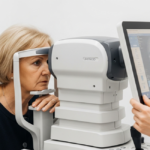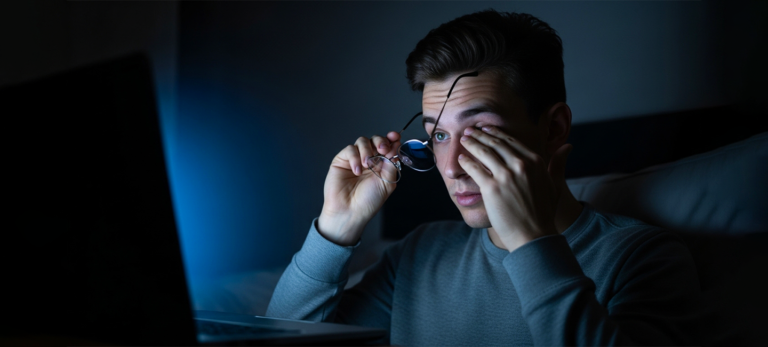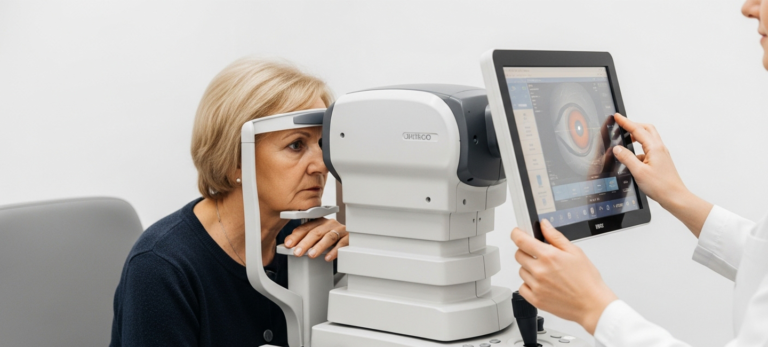Myopia Control for Kids: Why Early Action Matters More Than Ever The world has changed — and so have our children’s eyes. With the rise of digital learning, smartphones, and indoor lifestyles, myopia (nearsightedness) is growing at an alarming rate. According to the World Health Organization (WHO), half of the global population — nearly 5 …
Myopia Control for Kids: Why Early Action Matters More Than Ever
The world has changed — and so have our children’s eyes. With the rise of digital learning, smartphones, and indoor lifestyles, myopia (nearsightedness) is growing at an alarming rate.
According to the World Health Organization (WHO), half of the global population — nearly 5 billion people — will be myopic by 2050. Even more concerning, the average age of onset is dropping: kids are becoming nearsighted earlier, and progressing faster than ever before.
At My Eye Care, we believe early intervention can make a lifelong difference. This blog explains what myopia is, why it’s increasing, and how cutting-edge treatments like Ortho-K and MiSight lenses can help protect your child’s vision.
What Is Myopia (Nearsightedness)?
Myopia occurs when the eyeball grows too long or the cornea is too curved, causing light to focus in front of the retina instead of directly on it. This makes distant objects look blurry, while close-up vision remains clear.
Common Signs of Myopia in Kids:
- Squinting to see faraway objects
- Sitting too close to the TV or board at school
- Rubbing eyes frequently
- Complaining of headaches or eye strain
- Difficulty seeing in dim light
Fact: In the U.S., 42% of children aged 5–17 now have some degree of myopia — a dramatic increase from 25% in 1990 (National Eye Institute, 2024).
Source:
Why Myopia Rates Are Rising
1. Increased Screen Time & Near Work
Children today spend an average of 6–8 hours per day on digital devices. Studies show excessive near work (screens, reading, tablets) accelerates eye elongation, a key driver of myopia.
2. Lack of Outdoor Time
Natural daylight helps regulate eye growth. Kids who spend less than 90 minutes outdoors daily have a 40% higher risk of developing myopia.
3. Genetic Factors
If one parent is myopic, a child’s risk doubles. If both parents are, the risk triples. However, environment and habits remain the most controllable factors.
Source:
Why Early Myopia Control Is Crucial
Myopia doesn’t just cause blurry vision — it can lead to serious eye diseases later in life, including:
- Retinal detachment (5–10× higher risk in high myopia)
- Glaucoma (2× risk)
- Cataracts (earlier onset)
- Macular degeneration
Each -1.00 diopter increase in myopia raises the risk of retinal complications by 67%.
That’s why the goal isn’t just to correct vision — it’s to slow progression.
Source:
American Academy of Ophthalmology
Cutting-Edge Myopia Control Treatments
At My Eye Care, we offer clinically proven solutions to manage and slow childhood myopia. Here’s what every parent should know:
1. Orthokeratology (Ortho-K)
Ortho-K uses specially designed nighttime contact lenses that gently reshape the cornea while your child sleeps.
In the morning, lenses are removed — and your child enjoys clear vision all day without glasses or daytime contacts.
Clinical Results:
- Ortho-K can slow myopia progression by up to 50–60%
- Safe for children as young as 8 years old.
- Non-surgical and reversible.
Bonus: Ortho-K lenses also correct vision during wear, so children enjoy freedom from glasses during sports and school.
Source:
British Journal of Ophthalmology
2. MiSight® 1 Day Soft Contact Lenses
Developed by CooperVision and FDA-approved, MiSight lenses are daily disposable contacts that correct vision while actively slowing myopia progression.
How They Work:
They use a dual-focus design — part of the lens corrects vision, while another part creates a signal that slows eye growth.
Clinical Findings:
- In a 6-year study, MiSight lenses reduced myopia progression by 59% on average.
- The study also showed a 52% reduction in axial eye growth, which directly reduces risk of future eye disease.
Source:
3. Atropine Eye Drops
Low-dose atropine (0.01–0.05%) drops relax eye focusing muscles and have been shown to significantly slow myopia progression.
- Reduces myopia progression by up to 70% at low doses.
- Well-tolerated with minimal side effects.
- Often used alongside Ortho-K or glasses.
4. Specialized Myopia-Control Glasses
New lens technologies, such as DIMS (Defocus Incorporated Multiple Segments) lenses, are designed to control how light focuses on the retina, slowing elongation.
- Reduce myopia progression by up to 59%
- Suitable for young children not ready for contact lenses.
Lifestyle and Prevention Tips for Parents
1. Encourage Outdoor Play
Children should spend at least 2 hours outdoors daily.
Natural light exposure releases dopamine, which helps prevent eye elongation — a key cause of myopia.
2. Limit Screen Time
The American Academy of Pediatrics recommends:
- Ages 2–5: ≤1 hour/day of screen time
- Ages 6–12: ≤2 hours/day (excluding schoolwork)
3. Maintain Proper Reading Distance
Teach the “elbow rule” — keep reading materials at least an arm’s length away.
4. Ensure Regular Eye Exams
Annual exams can detect subtle vision changes before symptoms worsen. At My Eye Care, we track eye growth using axial length measurement, the most accurate way to monitor myopia.
Key Stats at a Glance
| Stat | Value | Source |
| Global myopia by 2050 | 50% of population | WHO |
| U.S. kids affected (2024) | 42% | NEI |
| Myopia increase since 1990 | +68% | CDC |
| Outdoor time needed | ≥2 hours/day | Journal of Ophthalmology |
| Risk reduction (MiSight) | 59% | CooperVision |
| Risk reduction (Ortho-K) | 50–60% | BJO 2023 |
Conclusion: Protect Your Child’s Future Vision
Myopia doesn’t have to define your child’s future.
Early detection and evidence-based treatments can slow or even halt progression, reducing lifelong risks of serious eye disease.
At My Eye Care, we combine compassionate pediatric care with cutting-edge myopia management solutions like Ortho-K, MiSight, and atropine therapy — giving your child the best chance for a lifetime of clear, healthy vision.
Schedule a pediatric eye exam today and help your child see a brighter, clearer future: Book Appointment.
Read more about:
Frequently Asked Questions:
1. What age can myopia control start?
Myopia control can start as early as age 6–8, once the child can cooperate with exams and lens use. Early intervention provides the greatest long-term benefit.
2. Can myopia be cured permanently?
There’s no permanent cure, but treatments like Ortho-K, MiSight lenses, and atropine drops can slow or stop progression effectively.
3. Are Ortho-K lenses safe for children?
Yes. Clinical trials confirm Ortho-K is safe and effective for children 8+, with a very low infection rate (<1 per 2,500 wearers per year).
4. How effective are MiSight contact lenses?
MiSight lenses reduce myopia progression by 59% and axial eye elongation by 52%, according to FDA-approved studies.
5. How long should my child wear Ortho-K lenses each night?
Typically, 6–8 hours of overnight wear is sufficient for full next-day correction and long-term control.
6. Are atropine drops safe for daily use?
Low-dose atropine (0.01–0.05%) is safe for long-term daily use with minimal side effects such as mild light sensitivity.
7. How often should children with myopia see the eye doctor?
Every 6 months for monitoring progression and adjusting treatment. Annual visits are recommended even if vision seems stable.
8. Can lifestyle changes alone stop myopia?
Outdoor play and screen-time limits help, but clinical interventions are usually necessary for moderate to high myopia.
9. What’s the difference between regular glasses and myopia-control glasses?
Regular glasses correct vision only, while myopia-control lenses like DIMS actively slow eye growth, reducing future risk of high myopia.
10. Why choose My Eye Care for myopia management?
At My Eye Care, we provide child-friendly exams, modern treatments (Ortho-K, MiSight, atropine), and personalized care — all guided by advanced imaging and tracking technology.




